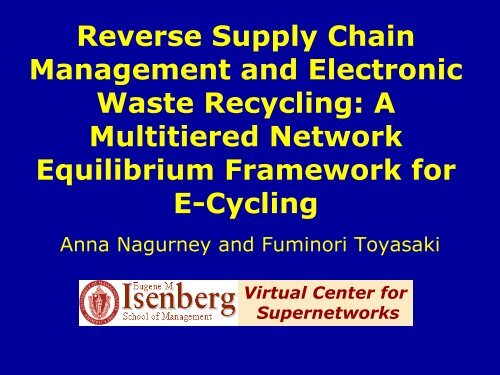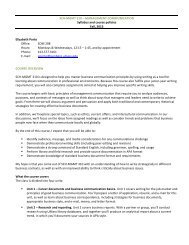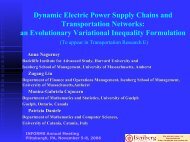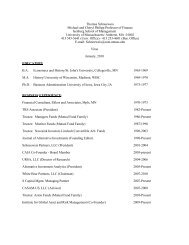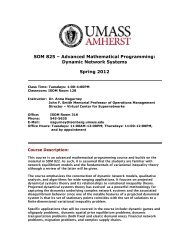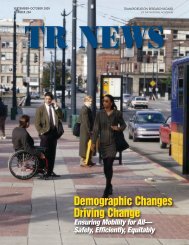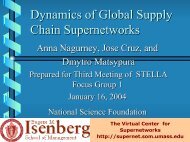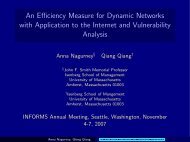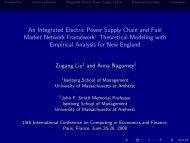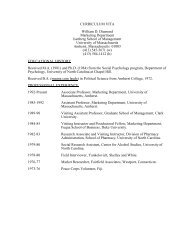Reverse Supply Chain Management and Electronic Waste Recycling
Reverse Supply Chain Management and Electronic Waste Recycling
Reverse Supply Chain Management and Electronic Waste Recycling
Create successful ePaper yourself
Turn your PDF publications into a flip-book with our unique Google optimized e-Paper software.
<strong>Reverse</strong> <strong>Supply</strong> <strong>Chain</strong><br />
<strong>Management</strong> <strong>and</strong> <strong>Electronic</strong><br />
<strong>Waste</strong> <strong>Recycling</strong>: A<br />
Multitiered Network<br />
Equilibrium Framework for<br />
E-Cycling<br />
Anna Nagurney <strong>and</strong> Fuminori Toyasaki<br />
Virtual Center for<br />
Supernetworks
This Research has been Supported<br />
by AT&T Industrial Ecology<br />
Fellowships
Background<br />
• 63 million PCs will be<br />
obsolete in 2003 in<br />
the U.S.<br />
(Appelbaum (2002)).<br />
• About 10 million<br />
electric waste<br />
products are dumped<br />
per year in Japan.<br />
(Appelbaum (2002)).<br />
• The shortage of l<strong>and</strong>fills<br />
• The problems of exporting hazardous materials<br />
to developing countries
Motivation<br />
Recent legislation both in the United States as well<br />
as abroad has attention on recycling electronic<br />
wastes.<br />
* Massachusetts in 2000 banned cathode-ray<br />
tubes from l<strong>and</strong>fills.<br />
* The Home Appliances <strong>Recycling</strong> Law in Japan<br />
(2001)<br />
* <strong>Waste</strong> from Electrical <strong>and</strong> <strong>Electronic</strong> Equipment<br />
directive (WEEE) in EU (2008)
Motivation<br />
• <strong>Electronic</strong> waste recycling differs from<br />
household recycling in two ways (Sodhi <strong>and</strong><br />
Reimer (2001)).<br />
1. <strong>Electronic</strong> wastes contain hazardous<br />
materials.<br />
2. <strong>Electronic</strong> wastes contain precious<br />
materials.<br />
* Collecting <strong>and</strong> processing electronic wastes<br />
may be feasible or profitable.
Motivation<br />
From supply chains to green logistics<br />
Legislative <strong>and</strong> consumer pressure lead<br />
manufactures to apply cradle-to-grave product<br />
management (Bloemhof-Ruwaard <strong>and</strong> et.al.<br />
(1995)).<br />
The need to manage E-cycling from the<br />
prospective of reverse supply chains.
Some Background for our Perspective
References<br />
Nagurney, A., Dong, J., <strong>and</strong> Zhang, D. (2002)<br />
“A supply chain network equilibrium model.”<br />
Transportation Research E 38, 282-303.<br />
Nagurney, A., Loo, J., Dong, J., <strong>and</strong> Zhang, D.<br />
(2002)<br />
“<strong>Supply</strong> chain networks <strong>and</strong> electronic commerce: a<br />
theoretical perspective.” Netnomics 4, 187-220.<br />
Nagurney, A., <strong>and</strong> Toyasaki, F. (2003)<br />
“<strong>Supply</strong> chain supernetworks <strong>and</strong> environmental<br />
criteria.” Transportation Research D 8, 185-213.
References<br />
Many researchers have studied recycling issues; see,for<br />
example,<br />
* Hoshino, T., Yura, K., <strong>and</strong> Hitomi, K. (1995)<br />
Maximize total profit <strong>and</strong> recycling rate<br />
Use linear programming<br />
* Stuart, J.A., Ammons, J.C., <strong>and</strong> Turbini, L.J. (1999)<br />
Capture comprehensively measurable<br />
corporate environmental impact considerations<br />
for the product life cycle<br />
Use mixed integer programming
References<br />
* Uzsoy, R., <strong>and</strong> Venkatachalam, G. (1998)<br />
Consider recycling problems in terms of<br />
supply chains<br />
Use linear programming<br />
* Sodhi, M.S., <strong>and</strong> Reimer, B. (2001)<br />
Optimization models for the sources, the<br />
recyclers, <strong>and</strong> the processors
The 4-Tiered E-Cycling Network
Assumptions of the Model<br />
• The prices <strong>and</strong> material flows are<br />
endogenously determined.<br />
• The sources generate a fixed amount of<br />
electronic waste.<br />
• The sources minimize their costs.<br />
• The recyclers <strong>and</strong> the processors<br />
maximize their profits, respectively.<br />
• Cournot-Nash oligopoly market.
Sources’ Behavior
Variational Inequality Formulation<br />
of the Sources
Recyclers’ Behavior
Processors’ Behavior
The Dem<strong>and</strong> Markets<br />
For all processors<br />
j ; j = 1,...,<br />
n
Variational Inequality Formulation
Variational Inequality<br />
Formulation
Qualitative Properties<br />
Bounded material flows<br />
<strong>and</strong> the imposition of a<br />
coercivity condition on<br />
dem<strong>and</strong> functions or a<br />
boundedness condition<br />
The existence of<br />
material flows <strong>and</strong><br />
the dem<strong>and</strong> prices<br />
is guaranteed.<br />
Under the strict<br />
monotonicity of F(x)<br />
The uniqueness<br />
is guaranteed.
The Algorithm<br />
Modified projection<br />
method of Korpelevich<br />
(1977)<br />
Step 0: Initialization<br />
Step 1: Computation<br />
This algorithm requires<br />
only monotonicity of<br />
F(x) <strong>and</strong> Lipshitz<br />
continuity condition.<br />
Step 2: Adaptation<br />
Step 3: Convergence<br />
Verification
Computation of the Top Tiers<br />
Material Flows<br />
The top-tiered material flows are computed explicitly<br />
but not with specific formulae, since these flows<br />
must lie in the feasible set K .
Computation of the Material Flows<br />
from the Recyclers to the<br />
Processors <strong>and</strong> the L<strong>and</strong>fill
Computation of the Material<br />
Flows from Processors to the<br />
Dem<strong>and</strong> Markets <strong>and</strong> the L<strong>and</strong>fill
Computation of the Prices
E-Cycling Network for the<br />
Numerical Examples
Common Input Data for Set 1<br />
Examples
Equilibrium Solutions to Set 1<br />
Examples (Baseline Set)
Common Input Data for Set 2<br />
Examples
Equilibrium Solutions to Set 2<br />
Examples (with Dem<strong>and</strong> Function<br />
Distinct from Set 1’s Examples)
Input Data for Set 3 Examples<br />
In Example 3.1, we used data identical to that of<br />
Example 2.1, except that the dem<strong>and</strong> functions<br />
were<br />
In Example 3.2, we used data identical to that of<br />
Example 3.1, except that the fixed unit prices<br />
associated with the sources using the l<strong>and</strong>fill.<br />
Example 3.3 had data identical to that in<br />
Example 3.2, except that the values of the<br />
conversion rates were
Equilibrium Solutions to Set 3<br />
Examples (with Dem<strong>and</strong> Functions<br />
Distinct at each Market)
Summary<br />
• Developed a rigorous E-cycling<br />
mathematical model<br />
( the endogenous equilibrium prices <strong>and</strong><br />
material shipments between tiers )<br />
• Provided qualitative properties of the<br />
equilibrium electronic waste material flow<br />
<strong>and</strong> price pattern<br />
• Provided numerical results
Thank You!<br />
For more information on this paper<br />
<strong>and</strong> the<br />
Virtual Center for Supernetworks<br />
<strong>and</strong> its activities see:<br />
http://supernet.som.umass.edu


